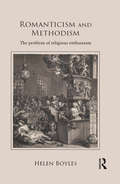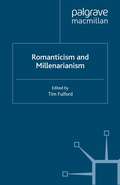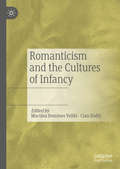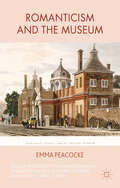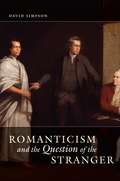- Table View
- List View
Romanticism and Methodism: The problem of religious enthusiasm
by Helen BoylesExploring the intense relationship between Romantic literature and Methodism, Helen Boyles argues that writers from both movements display an ambivalent attitude towards the expression of deep emotional and spiritual experience. Boyles takes up the disparaging characterization of William Wordsworth and other Romantic poets as 'Methodistical,' showing how this criticism was rooted in a suspicion of the 'enthusiasm' with which the Methodist movement was negatively identified. Historically, enthusiasm has generated hostility and embarrassment, a legacy that Boyles suggests provoked concerted efforts by Romantic poets such as Wordsworth and the Methodist leaders John and Charles Wesley to cleanse it of its derogatory associations. While they distanced themselves from enthusiasm's dangerous and hysterical manifestations, writers and religious leaders also identified with the precepts and inspiration of a language and religion of the heart. Boyles's analysis encompasses a range of literary genres from the Methodist sermon and hymn, to literary biography, critical review, lyric and epic poem. Balancing analysis of creative content with a consideration of its critical reception, she offers readers a detailed analysis of Wordsworth's relationship to popular evangelism within a analytical framework that incorporates Samuel Taylor Coleridge, Robert Southey, and William Hazlitt.
Romanticism and Millenarianism
by T. FulfordExpectation of the millennium was widespread in English society at the end of the eighteenth century. The essays in this volume explore how exactly, this expectation shaped, and was shaped by, the literature, art, and politics of the period we now call romantic. An expanded and rehistorized canon of writers and artists is assembled, a group united by a common tendency to use figurations of the millennium to interrogate and transform the worlds in which they lived and moved. Coleridge, Cowper, Blake, and Byron are placed in new contexts created by original research into the artistic and political subcultures of radical London, into the religious sects surrounding the Richard Brothers and Joanna Southcott, and into the cultural and political contexts of orientalism and empire.
Romanticism and Philosophy: Thinking with Literature (Routledge Studies in Romanticism)
by Sophie Laniel-Musitelli Thomas ConstantinescoThis volume brings together a wide range of scholars to offer new perspectives on the relationship between Romanticism and philosophy. The entanglement of Romantic literature with philosophy is increasingly recognized, just as Romanticism is increasingly viewed as European and Transatlantic, yet few studies combine these coordinates and consider the philosophical significance of distinctly literary questions in British and American Romantic writings. The essays in this book are concerned with literary writing as a form of thinking, investigating the many ways in which Romantic literature across the Atlantic engages with European thought, from 18th- and 19th-century philosophy to contemporary theory. The contributors read Romantic texts both as critical responses to the major debates that have shaped the history of philosophy, and as thought experiments in their own right. This volume thus examines anew the poetic philosophy of Wordsworth, Coleridge, Blake, Shelley, and Clare, also extending beyond poetry to consider other literary genres as philosophically significant, such as Jane Austen’s novels, De Quincey’s autofiction, Edgar Allan Poe’s tales, or Emerson’s essays. Grounded in complementary theoretical backgrounds and reading practices, the various contributions draw on an impressive array of writers and thinkers and challenge our understanding not only of Romanticism, but also of what we have come to think of as "literature" and "philosophy."
Romanticism and Philosophy: Thinking with Literature (Routledge Studies in Romanticism)
by Sophie Laniel-Musitelli Thomas ConstantinescoThis volume brings together a wide range of scholars to offer new perspectives on the relationship between Romanticism and philosophy. The entanglement of Romantic literature with philosophy is increasingly recognized, just as Romanticism is increasingly viewed as European and Transatlantic, yet few studies combine these coordinates and consider the philosophical significance of distinctly literary questions in British and American Romantic writings. The essays in this book are concerned with literary writing as a form of thinking, investigating the many ways in which Romantic literature across the Atlantic engages with European thought, from 18th- and 19th-century philosophy to contemporary theory. The contributors read Romantic texts both as critical responses to the major debates that have shaped the history of philosophy, and as thought experiments in their own right. This volume thus examines anew the poetic philosophy of Wordsworth, Coleridge, Blake, Shelley, and Clare, also extending beyond poetry to consider other literary genres as philosophically significant, such as Jane Austen’s novels, De Quincey’s autofiction, Edgar Allan Poe’s tales, or Emerson’s essays. Grounded in complementary theoretical backgrounds and reading practices, the various contributions draw on an impressive array of writers and thinkers and challenge our understanding not only of Romanticism, but also of what we have come to think of as "literature" and "philosophy."
Romanticism and Pleasure (Nineteenth-Century Major Lives and Letters)
by T. SchmidIn this text nine scholars discuss the aesthetics, culture, and science of pleasure in the Romantic period. Richard Sha, Denise Gigante, and Anya Taylor, among others, make a timely contribution to recent debates about issues of pleasure, taste, and appetite by looking anew at the work of figures such as Byron, Coleridge, and Austen.
Romanticism and Politics, 1789–1832
by Carol BoltonThe history of the Romantic period is often dominated by the cataclysmic political events that occurred within it The collection is divided into thematically linked sections, each of which is prefaced with brief notes on themes, issues and texts, and lists of books for further study. The dates of the period have been extended at the beginning to provide extracts from texts that frame the ensuing radical debate that arose around the French Revolution and concludes at the Reform Act of 1832, which can be seen as the culmination of the movement for political reform in the latter half of the Romantic period. The division of topic areas within the volumes into specific areas of interest will provide an easy route to negotiate the texts, whereas sections such as 'Women and politics' and 'Colonial politics' will highlight previously neglected areas.
Romanticism and Popular Magic: Poetry and Cultures of the Occult in the 1790s (Palgrave Studies in the Enlightenment, Romanticism and Cultures of Print)
by Stephanie Elizabeth ChurmsThis book explores how Romanticism was shaped by practices of popular magic. It seeks to identify the place of occult activity and culture – in the form of curses, spells, future-telling, charms and protective talismans – in everyday life, together with the ways in which such practice figures, and is refigured, in literary and political discourse at a time of revolutionary upheaval. What emerges is a new perspective on literature’s material contexts in the 1790s – from the rhetorical, linguistic and visual jugglery of the revolution controversy, to John Thelwall’s occult turn during a period of autobiographical self-reinvention at the end of the decade. From Wordsworth’s deployment of popular magic as a socially and politically emancipatory agent in Lyrical Ballads, to Coleridge’s anxious engagement with superstition as a despotic system of ‘mental enslavement’, and Robert Southey’s wrestling with an (increasingly alluring) conservatism he associated with a reliance on ultimately incarcerating systems of superstition.
Romanticism and Pragmatism: Richard Rorty and the Idea of a Poeticized Culture
by U. SchulenbergThis interdisciplinary project is situated at the boundary between literary studies and philosophy. Its chief focus is on American Romanticism and it examines work by a number of prominent writers and philosophers, from Whitman and Thoreau to Barthes and Rorty.
Romanticism and Religion from William Cowper to Wallace Stevens
by Gavin HoppsThe relationship between literature and religion is one of the most groundbreaking and challenging areas of Romantic studies. Covering the entire field of Romanticism from its eighteenth-century origins in the writing of William Cowper and its proleptic stirrings in Paradise Lost to late-twentieth-century manifestations in the work of Wallace Stevens, the essays in this timely volume explore subjects such as Romantic attitudes towards creativity and its relation to suffering and religious apprehension; the allure of the 'veiled' and the figure of the monk in Gothic and Romantic writing; Miltonic light and inspiration in the work of Blake, Wordsworth, Shelley, and Keats; the relationship between Southey's and Coleridge's anti-Catholicism and definitions of religious faith in the Romantic period; the stammering of Romantic attempts to figure the ineffable; the emergence of a feminised Christianity and a gendered sublime; the development of Calvinism and its role in contemporary religious controversies. Its primary focus is the canonical Romantic poets, with a particular emphasis on Byron, whose work is most in need of critical re-evaluation given its engagement with the Christian and Islamic worlds and its critique of totalising religious and secular readings. The collection is an original and much-needed intervention in Romantic studies, bringing together the contextual awareness of recent historicist scholarship with the newly awakened interest in matters of form and an appreciation of the challenges of postmodern theory.
Romanticism and Religion from William Cowper to Wallace Stevens
by Gavin HoppsThe relationship between literature and religion is one of the most groundbreaking and challenging areas of Romantic studies. Covering the entire field of Romanticism from its eighteenth-century origins in the writing of William Cowper and its proleptic stirrings in Paradise Lost to late-twentieth-century manifestations in the work of Wallace Stevens, the essays in this timely volume explore subjects such as Romantic attitudes towards creativity and its relation to suffering and religious apprehension; the allure of the 'veiled' and the figure of the monk in Gothic and Romantic writing; Miltonic light and inspiration in the work of Blake, Wordsworth, Shelley, and Keats; the relationship between Southey's and Coleridge's anti-Catholicism and definitions of religious faith in the Romantic period; the stammering of Romantic attempts to figure the ineffable; the emergence of a feminised Christianity and a gendered sublime; the development of Calvinism and its role in contemporary religious controversies. Its primary focus is the canonical Romantic poets, with a particular emphasis on Byron, whose work is most in need of critical re-evaluation given its engagement with the Christian and Islamic worlds and its critique of totalising religious and secular readings. The collection is an original and much-needed intervention in Romantic studies, bringing together the contextual awareness of recent historicist scholarship with the newly awakened interest in matters of form and an appreciation of the challenges of postmodern theory.
Romanticism and Revolution: A Reader
by Jon Mee David FallonRomanticism and Revolution: A Readerpresents an anthology of the key texts that both defined the debate over the French Revolution during the 1790s and influenced the Romantic authors. Presents readings chronologically to allow readers to experience the unfolding of the debate as it occurred in the 1790s Provides an accessible and in-depth sampling of the major contributors to the Revolution debate, from Price, Burke, and Paine to Wollstonecraft and Godwin
Romanticism and Revolution: A Reader
by Jon Mee David FallonRomanticism and Revolution: A Readerpresents an anthology of the key texts that both defined the debate over the French Revolution during the 1790s and influenced the Romantic authors. Presents readings chronologically to allow readers to experience the unfolding of the debate as it occurred in the 1790s Provides an accessible and in-depth sampling of the major contributors to the Revolution debate, from Price, Burke, and Paine to Wollstonecraft and Godwin
Romanticism and Speculative Realism
by Anne C. McCarthy Chris WashingtonRomanticism and Speculative Realism features a range of scholars working at the intersection of literary poetics and philosophy. It considers how the writing of the Romantic era reconceptualizes the human imagination, the natural world, and the language that correlates them in radical ways that can advance current speculative debates concerning new ontologies and new materialisms. In their wide-ranging examinations of canonical and non-canonical romantic writers, the scholars gathered here rethink the connections between the human and non-human world to envision speculative modes of social being and ecological politics. Spanning historical and national frameworks-from historical romanticism to contemporary post-romantic ecology, and from British and German romanticism to global modernity-these essays examine life in all its varied forms in, and beyond, the Anthropocene.
Romanticism and Speculative Realism
by Anne C. McCarthy Chris WashingtonRomanticism and Speculative Realism features a range of scholars working at the intersection of literary poetics and philosophy. It considers how the writing of the Romantic era reconceptualizes the human imagination, the natural world, and the language that correlates them in radical ways that can advance current speculative debates concerning new ontologies and new materialisms. In their wide-ranging examinations of canonical and non-canonical romantic writers, the scholars gathered here rethink the connections between the human and non-human world to envision speculative modes of social being and ecological politics. Spanning historical and national frameworks-from historical romanticism to contemporary post-romantic ecology, and from British and German romanticism to global modernity-these essays examine life in all its varied forms in, and beyond, the Anthropocene.
Romanticism and the City (Nineteenth-Century Major Lives and Letters)
by Larry H. PeerRomanticism and the City explores how late eighteenth and early nineteenth century literature conceptualized urban space. Fresh readings of key texts show how Romantic concerns with urban life shaped both individual works and broad theoretical issues in European Romanticism at large.
Romanticism and the Contingent Self: The Challenge of Representation (Palgrave Studies in the Enlightenment, Romanticism and Cultures of Print)
by Michael FalkThis book offers a new critique of selfhood in Romantic literature. In the past, Romanticism has been seen as an individualistic movement, with writers believing in the ‘centrality’ of the self. Challenging this prevailing view of Romanticism and the modern self, this study unveils an alternative tradition of Romantic writing in which the self is fragile, degenerate, non-existent – or in a word, contingent. It combines philosophy, intellectual history, literary studies and digital humanities and takes a transnational approach both in its coverage of philosophical thought and literature, including case studies from England, Ireland, Scotland and colonial Australia, with examples from American and European works as well. The book also uses innovative digital techniques such as text analysis, sentiment mining and network analysis to enrich the exploration of text and context. It covers all major genres of Romantic writing: fiction (realist novels), poetry (the sonnet), non-fiction prose (biography) and drama (gothic tragedy). Providing a new framework for understanding the contingent self, this book is of interest to scholars and students of Romantic literature, philosophy of the self and digital humanities.
Romanticism and the Cultures of Infancy
by Martina Domines Veliki Cian DuffyThis collection of essays explores the remarkable range and cultural significance of the engagement with ‘infancy’ during the Romantic period. Taking its point of departure in the commonplace claim that the Romantics invented childhood, the book traces that engagement across national boundaries, in the visual arts, in works of educational theory and natural philosophy, and in both fiction and non-fiction written for children. Essays authored by scholars from a range of national and disciplinary backgrounds reveal how Romantic-period representations of and for children constitute sites of complex discursive interaction, where ostensibly unrelated areas of enquiry are brought together through common tropes and topoi associated with infancy. Broadly new-historicist in approach, but drawing also on influential theoretical descriptions of genre, discipline, mediation, cultural exchange, and comparative methodologies, the collection also seeks to rethink the idea of a clear-cut dichotomy between Enlightenment and Romantic conceptions of infancy.
Romanticism and the Gold Standard: Money, Literature, and Economic Debate in Britain 1790-1830 (Palgrave Studies in the Enlightenment, Romanticism and Cultures of Print)
by A. DickThrough a close analysis of the pamphlets, reviews, lectures, journalism, editorials, poems, and novels surrounding the introduction of the gold standard in 1816, this book examines the significance of monetary policy and economic debate to the culture and literature of Britain during the age of Romanticism.
Romanticism and the Letter (Palgrave Studies in the Enlightenment, Romanticism and Cultures of Print)
by Madeleine Callaghan Anthony HoweRomanticism and the Letter is a collection of essays that explore various aspects of letter writing in the Romantic period of British Literature. Although the correspondence of the Romantics constitutes a major literary achievement in its own right, it has received relatively little critical attention. Essays focus on the letters of major poets, including Wordsworth, Byron, Shelley and Keats; novelists and prose writers, including Jane Austen, Leigh Hunt and Charles Lamb; and lesser-known writers such as Melesina Trench and Mary Leadbeater. Moving from theories of letter writing, through the period’s diverse epistolary culture, to essays on individual writers, the collection opens new perspectives for students and scholars of the Romantic period.
Romanticism and the Museum (Palgrave Studies in the Enlightenment, Romanticism and Cultures of Print)
by Mo Malek E. PeacockeRomanticism and the Museum argues that museums were integral to Britain's understanding of itself as a nation in the wake of the French Revolution. It features Wordsworth, Scott, Edgeworth, and literary periodicals featuring Byron and Horace Smith.
Romanticism and the Object (Nineteenth-Century Major Lives and Letters)
by L. PeerWhy are material objects so prominent in European Romantic literature, both as symbol and organizing device? This collection of essays maintains that European Romantic culture and its aesthetic artifacts were fundamentally shaped by "object aesthetics," an artistic idiom of acknowledging, through a profound and often disruptive use of objects, the movement of Western aesthetic practice into Romantic self-projection and imagination. Of course Romanticism, in all its dissonance and anxiety, is marked by a number of new artistic practices, all of which make up a new aesthetics, accounting for the dialectical and symbolistic view of literature that began in the late eighteenth century. Romanticism and the Object adds to our understanding of that aesthetics by reexamining a wide range of texts in order to discover how the use of objects works in the literature of the time.
Romanticism and the Question of the Stranger
by David SimpsonIn our post-9/11 world, the figure of the stranger—the foreigner, the enemy, the unknown visitor—carries a particular urgency, and the force of language used to describe those who are “different” has become particularly strong. But arguments about the stranger are not unique to our time. In Romanticism and the Question of the Stranger, David Simpson locates the figure of the stranger and the rhetoric of strangeness in romanticism and places them in a tradition that extends from antiquity to today. Simpson shows that debates about strangers loomed large in the French Republic of the 1790s, resulting in heated discourse that weighed who was to be welcomed and who was to be proscribed as dangerous. Placing this debate in the context of classical, biblical, and other later writings, he identifies a persistent difficulty in controlling the play between the despised and the desired. He examines the stranger as found in the works of Coleridge, Austen, Scott, and Southey, as well as in depictions of the betrayals of hospitality in the literature of slavery and exploration—as in Mungo Park's Travels and Stedman's Narrative—and portrayals of strange women in de Staël, Rousseau, and Burney. Contributing to a rich strain of thinking about the stranger that includes interventions by Ricoeur and Derrida, Romanticism and the Question of the Stranger reveals the complex history of encounters with alien figures and our continued struggles with romantic concerns about the unknown.
Romanticism and the Question of the Stranger
by David SimpsonIn our post-9/11 world, the figure of the stranger—the foreigner, the enemy, the unknown visitor—carries a particular urgency, and the force of language used to describe those who are “different” has become particularly strong. But arguments about the stranger are not unique to our time. In Romanticism and the Question of the Stranger, David Simpson locates the figure of the stranger and the rhetoric of strangeness in romanticism and places them in a tradition that extends from antiquity to today. Simpson shows that debates about strangers loomed large in the French Republic of the 1790s, resulting in heated discourse that weighed who was to be welcomed and who was to be proscribed as dangerous. Placing this debate in the context of classical, biblical, and other later writings, he identifies a persistent difficulty in controlling the play between the despised and the desired. He examines the stranger as found in the works of Coleridge, Austen, Scott, and Southey, as well as in depictions of the betrayals of hospitality in the literature of slavery and exploration—as in Mungo Park's Travels and Stedman's Narrative—and portrayals of strange women in de Staël, Rousseau, and Burney. Contributing to a rich strain of thinking about the stranger that includes interventions by Ricoeur and Derrida, Romanticism and the Question of the Stranger reveals the complex history of encounters with alien figures and our continued struggles with romantic concerns about the unknown.
Romanticism and the Question of the Stranger
by David SimpsonIn our post-9/11 world, the figure of the stranger—the foreigner, the enemy, the unknown visitor—carries a particular urgency, and the force of language used to describe those who are “different” has become particularly strong. But arguments about the stranger are not unique to our time. In Romanticism and the Question of the Stranger, David Simpson locates the figure of the stranger and the rhetoric of strangeness in romanticism and places them in a tradition that extends from antiquity to today. Simpson shows that debates about strangers loomed large in the French Republic of the 1790s, resulting in heated discourse that weighed who was to be welcomed and who was to be proscribed as dangerous. Placing this debate in the context of classical, biblical, and other later writings, he identifies a persistent difficulty in controlling the play between the despised and the desired. He examines the stranger as found in the works of Coleridge, Austen, Scott, and Southey, as well as in depictions of the betrayals of hospitality in the literature of slavery and exploration—as in Mungo Park's Travels and Stedman's Narrative—and portrayals of strange women in de Staël, Rousseau, and Burney. Contributing to a rich strain of thinking about the stranger that includes interventions by Ricoeur and Derrida, Romanticism and the Question of the Stranger reveals the complex history of encounters with alien figures and our continued struggles with romantic concerns about the unknown.
Romanticism and the Question of the Stranger
by David SimpsonIn our post-9/11 world, the figure of the stranger—the foreigner, the enemy, the unknown visitor—carries a particular urgency, and the force of language used to describe those who are “different” has become particularly strong. But arguments about the stranger are not unique to our time. In Romanticism and the Question of the Stranger, David Simpson locates the figure of the stranger and the rhetoric of strangeness in romanticism and places them in a tradition that extends from antiquity to today. Simpson shows that debates about strangers loomed large in the French Republic of the 1790s, resulting in heated discourse that weighed who was to be welcomed and who was to be proscribed as dangerous. Placing this debate in the context of classical, biblical, and other later writings, he identifies a persistent difficulty in controlling the play between the despised and the desired. He examines the stranger as found in the works of Coleridge, Austen, Scott, and Southey, as well as in depictions of the betrayals of hospitality in the literature of slavery and exploration—as in Mungo Park's Travels and Stedman's Narrative—and portrayals of strange women in de Staël, Rousseau, and Burney. Contributing to a rich strain of thinking about the stranger that includes interventions by Ricoeur and Derrida, Romanticism and the Question of the Stranger reveals the complex history of encounters with alien figures and our continued struggles with romantic concerns about the unknown.
